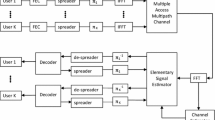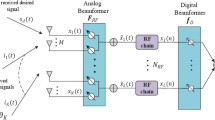Abstract
Today, the increase in the demand for mobile communication and the increasing need for data transfer have reached great dimensions. In order to meet this need, multi-input multi-output (MIMO) can be increased by significantly increasing the number of antennas in the base station by making more use of the spatial multiplexing capability. With the significant increase in the number of antennas, the concept of massive MIMO has emerged. In massive MIMO systems, like many other communication systems, the channel status information of the channels must be obtained. Therefore, channel estimation methods are used to meet the need for channel state information. The least squares algorithm, which is one of the simple channel estimation techniques, is one of the most preferred techniques in this field. In this paper, pilot tone optimization was applied in the least squares channel estimation method by using elephant herding optimization (EHO) technique in massive MIMO systems. When performance of EHO is compared with performances of genetic algorithm, particle swarm optimizations, invasive weed optimization, harmony search and random forest algorithm it is seen that the EHO is the most successful algorithm. For example, in the calculations made in cases where the signal-to-noise ratio value is 18 dB, mean squared error was calculated as 2.88 × 10–5 with genetic algorithm, 2.76 × 10–5 with particle swarm optimization, 2.75 × 10–5 with invasive weed optimization, 2.60 × 10–5 with harmony search, and 2.63 × 10–5 with random forest algorithm, while it was calculated as 2.49 × 10–5 with EHO. When the pilots' positions were determined using EHO, the number of erroneous bits sent significantly decreased compared to both random placement and placement at equal intervals. This situation can be considered a significant achievement for a channel estimation process that involves extremely low processing load.









Similar content being viewed by others
Data availability
The data which are results of this study can be obtained from the relevant author upon request.
Code Availability
The processed code cannot be shared at this time as the code also forms part of an ongoing study.
References
Björnson, E., Hoydis, J., & Sanguinetti, L. (2017). Massive MIMO networks: Spectral, energy and hardware efficiency. Foundation and Trends in Signal Processing, 11(3–4), 154–655.
Ngo, H. Q. (2015). Massive MIMO: Fundamentals and system designs. Division of Communication Systems, Department of Electrical Engineering, ISY Linköping University
Gholami-Dadkan, S., Abbasi-Moghadam, D., & Kalantarinejad, N. (2022). Reducing the jamming effects in multicellular Massive MIMO systems. International Journal of Communication Systems, 35(10), e5160.
Hajjaj, M. (2022). Iterative Newton hard thresholding-based approach for cosparse recovery of mmWave massive MIMO channels. International Journal of Communication Systems, 35(6), e5092.
Zbairi, M., Ez-zazi, I., Yazid, Y., Arioua, M., & El Oualkadi, A. (2022). On the spectral efficiency of cell-free massive MIMO system in irregular 5G mobile networks. International Journal of Communication Systems, 35(12), e5205.
Gaspar, G. R. (2016). Channel estimation in massive MIMO systems. Faculdade de Ciências e Tecnologia, Universidade Nova de Lisboa
Mezghani, A., & Swindlehurst, A. L. (2018). Blind estimation of sparse broadband massive MIMO channels with ideal and one-bit ADCs. IEEE Transactions on Signal Processing, 66(11), 2972–2983.
Li, Y., Tao, C., Liu, L., Seco-Granados, G., & Lee Swindlehurst, A. (2016). Channel estimation and uplink achievable rates in one-bit massive MIMO systems. In Proceedings of the IEEE sensor array and multichannel signal processing workshop (pp. 1–5)
Murata, T., & Ishibuchi, H. (1995). MOGA: Multiobjective genetic algorithms. In Proceedings of 1995 IEEE international conference on evolutionary computation (pp. 289–294)
Coello, C. A. C., Pulido, G. T., & Lechuga, M. S. (2004). Handling multiple objectives with particle swarm optimization. IEEE Transactions on Evolutionary Computation, 8(3), 256–279.
Dadalipour, B., Mallahzadeh, A. R., & Davoodi-Rad, Z. (2008). Application of the invasive weed optimization technique for antenna configurations. In Proceedings of Loughborough antennas and propagation conference (pp. 425–428)
Şimşir, Ş, & Taşpınar, N. (2018). Advanced pilot design procedure based on HS algorithm for OFDM-IDMA system. IET Communications, 12(10), 1155–1162.
Saha, A., Basu, S., & Datta, A. (2020). Random forests for dependent data. New York: Cornell University.
Wang, G., Deb, S., & Coelho, L. S. (2015). Elephant herding optimization. In: Proceedings of 3rd international symposium on computational and business intelligence (pp. 1–5)
Bhange, D., & Dethe, C. (2018). A novel LS/LMMSE based PSO approach for 3D-channel estimation in Rayleigh fading. Advanced Electromagnetics, 7, 117–123.
Sohail, M. F., Ghauri, S. A., & Alam, S. (2017). Channel estimation in massive MIMO systems using heuristic approach. Wireless Personal Communications, 97, 6483–6498.
Noman, K., Islam, S., Hassan, S., & Pervin, R. (2018). An improved data aided channel estimation technique using genetic algorithm for massive MIMO. In International conference on machine learning and data engineering (pp. 61–66)
Al Ayidh, A., Sambo, Y., & Imran, M. A. (2022). Mitigation pilot contamination based on matching technique for uplink cell-free massive MIMO systems. Scientific Reports, 12, e16893.
Padmaja, C., & Malleswari, B. L. (2023). Turbo-coded Mimo-OFDM channel estimation using the chaotic grey wolf optimizer and genetic algorithm. IETE Journal of Research. https://doi.org/10.1080/03772063.2023.2180227
Hasan, M. K., Hosain, S., Saha, T., Islam, S., Paul, L. C., Khatak, S., Alkhassawneh, H. M., Kariri, E., Ahmed, E., & Hassan, R. (2022). Energy efficient data detection with low complexity for an uplink multi-user massive MIMO system. Computers and Electrical Engineering, 101, e108045.
Hossain, M., Suman, A., & Paul, L. C. (2014). DFT based channel estimation analysis in OFDM supported. International Journal of Hybrid Information Technology, 7(3), 391–400.
Yu, W., He, H., Yu, X., Song, S., Zhang, J., & Letaief, K. B. (2023). Blind performance prediction for deep learning based ultra-massive MIMO channel estimation. In IEEE international conference on communications (pp. 2613–2618)
Moqbel, M. A. M., Wangdong, W., & Ali, A. Z. (2017). MIMO channel estimation using the LS and MMSE algorithm. IOSR Journal of Electronics and Communication Engineering, 12, 13–22.
Osman, S., Mowla, M. M., Paul, P., & Paul, L. C. (2019). Energy-efficient hybrid precoding analysis in 5G mmwave massive MIMO systems with large antenna arrays. In Proceedings of 3rd international conference on electrical, computer & telecommunication engineering (pp. 97–100)
Uthansakul, P., & Khan, A. A. (2019). On the energy efficiency of millimeter wave massive MIMO based on hybrid architecture. Energies, 12(11), 2227.
Osman, S., Mowla, M. M., Paul, P., & Paul, L. C. (2019). Energy-efficient hybrid precoding analysis in 5G mmwave massive MIMO systems in different channels. In Proceedings of 3rd international conference on electrical, computer & telecommunication engineering (pp. 101–104)
Ali, S. K., Khan, A. A., Perarasi, T., Rehman, A. U., & Ouahada, K. (2023). Learned-SBL-GAMP based hybrid precoders/combiners in millimeter wave massive MIMO systems. PLoS ONE, 18(9), e0289868.
Mahmud, M. H., Khaleduzzaman, K., Sarker, S., & Paul, L. C. (2020). Effect of path loss models on performance of 5G compatible MIMO window-OFDM systems. In Proceedings of 2020 international conference on smart technologies in computing, electrical and electronics (pp. 257–262)
Uthansakul, P., Khan, A. A., Uthansakul, M., & Duangmanee, P. (2018). Energy efficient design of massive MIMO based on closely spaced antennas: Mutual coupling effect. Energies, 11, 2029.
Khan, A. A., Uthansakul, P., Duangmanee, P., & Uthansakul, M. (2018). Energy efficient design of massive MIMO by considering the effects of nonlinear amplifiers. Energies, 11(5), 1045.
Björnson, E., Larsson, E., & Marzetta, T. (2016). Massive MIMO: Ten myths and one critical question. IEEE Communications Magazine, 54, 114–123.
Kanaka Chary, M., Vamshi Krishna, C. H., & Rama Krishna, D. (2024). Accurate channel estimation and hybrid beamforming using Artificial Intelligence for massive MIMO 5G systems. AEU International Journal of Electronics and Communications, 173, e154971.
Li, Y., Tao, C., Seco-Granados, G., Mezghani, A., Lee Swindlehurst, A., & Liu, L. (2017). Channel estimation and performance analysis of one-bit massive MIMO systems. IEEE Transactions on Signal Processing, 65(15), 4075–4089.
Bergaoui, H., Mlayeh, Y., & Tlili, F. (2021). Adaptive pilot pattern for massive MIMO systems. IEEE Access, 9, 81115–81124.
Kumar, M. E., & Rajasekhar, K. S. (2015). MMSE channel estimation for MIMO-OFDM using spatial and temporal correlations. Acharya Nagarjuna University (pp. 550–555)
Tian, Y., & Magaña, M. (2021). Pilot-aided channel estimation for massive MIMO systems in TDD-mode using Walsh-Hadamard transformed subsampled data at the base station. Wireless Personal Communications, 119, 423–440.
Funding
This study received no specific grant from any funding agency in the public, commercial, or not-for-profit sectors.
Author information
Authors and Affiliations
Contributions
The first author provided technical guidance and supervision. The literature research and optimization process were done by the second and third authors.
Corresponding author
Ethics declarations
Conflict of interest
The authors declare that there is no conflict of interest regarding the publication of this paper.
Additional information
Publisher's Note
Springer Nature remains neutral with regard to jurisdictional claims in published maps and institutional affiliations.
Rights and permissions
Springer Nature or its licensor (e.g. a society or other partner) holds exclusive rights to this article under a publishing agreement with the author(s) or other rightsholder(s); author self-archiving of the accepted manuscript version of this article is solely governed by the terms of such publishing agreement and applicable law.
About this article
Cite this article
Taşpınar, N., Ergeç, A. & Gül, B.K. Pilot Tones Design for Channel Estimation Using Elephant Herding Optimization Algorithm in Massive MIMO Systems. Wireless Pers Commun 133, 1917–1934 (2023). https://doi.org/10.1007/s11277-024-10858-1
Accepted:
Published:
Issue Date:
DOI: https://doi.org/10.1007/s11277-024-10858-1




